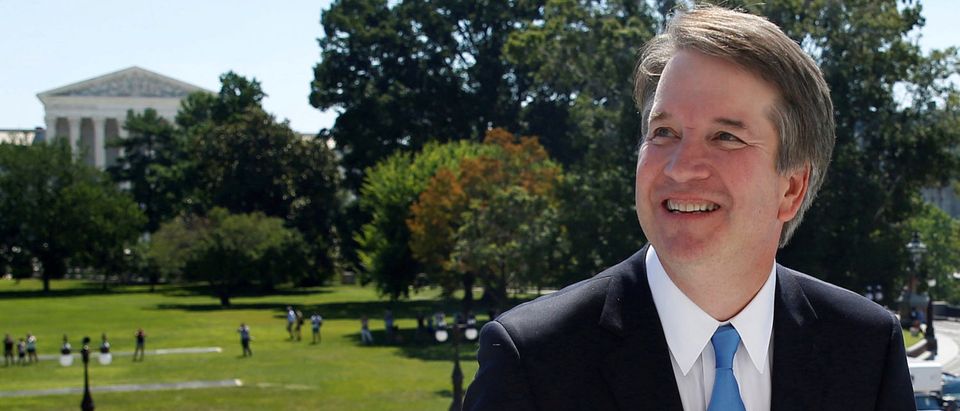- Judge Brett Kavanaugh can’t explain two-thirds of his recusals from matters before the D.C. Circuit.
- Democrats say the unexplained recusals underscore the need for thorough review of the documents he generated in the George W. Bush White House, which totals over one million records.
- Good government groups add that such problems could be avoided if courts publicly disclosed the reasons for judicial recusals.
Judge Brett Kavanaugh cannot explain two-thirds of his recusals from matters before the U.S. Court of Appeals for the D.C. Circuit.
The judge was required to submit a list of cases from which he removed himself given conflicts of interest to the Senate Judiciary Committee as an appendix to a detailed questionnaire on professional and personal matters. He could not recall the reason for his recusal in 90 of the 136 cases.
The unexplained recusals limit insights into the parties or issue areas that trigger conflicts of interest on Kavanaugh’s end.
Democratic Sen. Chris Coons of Delaware speculated that the recusals relate to his work as an aide to former President George W. Bush.
“I would guess it was from work he had done in the Bush administration,” Coons told The Daily Caller News Foundation. “That highlights ways in which his advocacy work and his political work could have been complicating for his judicial service. I think we need to understand that. Transparency is critical.”
Coons, who sits on the judiciary committee, also said the missing recusal data underscores the importance of a full and complete production of documents relating to Kavanaugh’s work in the White House. Senate Democrats argue the full range of Kavanaugh’s work product should be made available to the committee, while Republicans counter that the panel generally reviews a relevant and proportional sample of records when executive branch officials are nominated to the federal bench. (RELATED: Mitch McConnell Is Ready To Play Hardball To Get Kavanaugh Confirmed)
By way of comparison, the last appointee to the Supreme Court, Justice Neil Gorsuch, recused from over 1,000 cases as a judge on the 10th U.S. Circuit Court of Appeals. He did not list reason for excusing himself in approximately 130 cases on his 2017 questionnaire. Gorsuch’s number of recusals is higher as a raw number, but lower as a proportion.
Federal judges issue terse recusal notices when removing themselves from a case, which generally do not explain why they are disqualified from participation in a given matter. As such, the reason for recusal is often discovered by inference.
What’s more, many federal courts do not even maintain an internal system for memorializing the reasons behind judicial recusals, making judges and their staffs the primary custodians of recusal records. Kavanaugh noted that the D.C. Circuit’s network does not document the reasons for particular recusals in his response to the judiciary committee.
“The D.C. Circuit does not require judges to list their reasons for sua sponte recusals, which are left to each judge’s discretion,” Kavanaugh wrote on the questionnaire. “As a consequence, and because the court’s data systems often do not contain the reasons for recusals, I am unable to reconstruct with sufficient certainty the reasons for recusals in the following cases.”
Fix the Court, a nonpartisan judicial watchdog, pointed out that five justices currently serving on the Supreme Court have belatedly recused themselves from cases in which they have conflicts in recent years. In four instances, the justices recused only after the cases were argued at the high court. Without a more precise accounting of past recusals, Fix the Court suggested Kavanaugh might accidentally participate in matters from which he excused himself in the past.
“It is concerning that overall Kavanaugh can’t recall the reasoning behind two-thirds of his recusals since joining the federal bench,” Fix the Court executive director Gabe Roth told TheDCNF. “Given that issues tend to resurface in federal court, without a full accounting — or even a single sentence — on why a conflict exists and a recusal occurred, there’s a fair chance a judge or justice will make an error and forget to step aside the second time around.”
Roth added that this problem would largely be avoided if courts recorded and publicized federal judges’ rationales when disqualifying themselves from cases.
“Federal courts should consider adopting the practice of appending a few words to their judges’ and justices’ recusal notices, so that the public can know the jurist took no part in a case, say, ‘due to a financial interest’ or ‘because the judge was involved at an earlier stage of the litigation,'” Roth said.
Kavanaugh did explain his recusals in 46 other cases, several of which pertained to high profile political conflicts involving the Bush administration. These matters include a civil suit Valerie Plame brought against several government officials for revealing her CIA affiliation, and a suit seeking to enforce a congressional subpoena requiring White House aides to produce information relating to the dismissal of nine federal prosecutors.
Robert Donachie contributed to the reporting of this article.
Send tips to kevin@dailycallernewsfoundation.org.
All content created by the Daily Caller News Foundation, an independent and nonpartisan newswire service, is available without charge to any legitimate news publisher that can provide a large audience. All republished articles must include our logo, our reporter’s byline and their DCNF affiliation. For any questions about our guidelines or partnering with us, please contact licensing@dailycallernewsfoundation.org.


